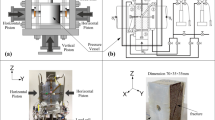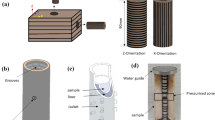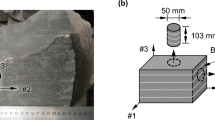Abstract
In deep underground geotechnical engineering, water–rock interaction emerges as a critical factor influencing the stability of engineering rock masses. This study delves into the macroscopic nonlinear mechanical behavior and fracture characteristics of natural water-bearing and saturated sandstone samples under various true triaxial stress states. The objective is to systematically elucidate the impact of actual three-dimensional stress conditions and water content on the mechanical behavior and fracture mechanisms of sandstone formations. The findings reveal significant anisotropic deformation in sandstone under 3D stress, while saturated sandstone exhibits robust plastic deformation capacity. Moreover, changes in the strain ratio coefficient are identified as precursors to rock fracture. The dilatation behavior of sandstone weakens progressively with increasing σ2, indicating reduced expansion in saturated sandstone. To account for the influence of σ2, a novel dilation index is proposed. The true triaxial strength of sandstone demonstrates a close relationship with both σ2 and water content, with strength initially increasing before declining as σ2 rises. In addition, water significantly undermines sandstone strength, although this weakening trend moderates with increasing σ2. Morphological analysis and SEM observations unveil three-dimensional volume fracturing characteristics in rock fractures, primarily characterized by shear accompanied by tensile fractures. Saturated sandstone samples, in contrast, exhibit numerous tensile and intergranular fractures. Overall, this study holds paramount practical significance for the evaluation of rock stability and the design of water-bearing engineering rock masses, encompassing domains, such as geology, water conservancy, and mining.
Highlights
-
The influence of the σ2 and water on the nonlinear mechanical behavior of sedimentary sandstone was studied.
-
A new dilatation index and strength criterion considering the effect of the σ2 was proposed.
-
The 3D fracture morphology and failure network characteristics of sandstone was analyzed.
-
Mesoscopic fracture mechanism of the σ2 and water on sandstone was revealed.





















Similar content being viewed by others
Abbreviations
- σ 1, σ 2,σ 3 :
-
Major, intermediate, and minor principal stress
- ε 1, ε 2, ε 3, ε v :
-
Major, intermediate, minor, and volumetric strain
- E, υ :
-
Deformation modulus, Poisson's ratio
- υ 13, υ 12, υ 23 :
-
Strain ratio coefficient
- \(\dot{\varepsilon }_{{1}}^{{\text{p}}}\), \(\dot{\varepsilon }_{{\text{v}}}^{{\text{p}}}\) :
-
Increment plastic axial strain and increment plastic volume strain
- ψ :
-
Dilatancy angle
- I d :
-
Dilatation index
- \(\Delta \dot{\varepsilon }_{{\text{v}}}^{{\text{p}}}\), \(\Delta \dot{\varepsilon }_{{1}}^{{\text{p}}}\) :
-
Incremental plastic volumetric strain and incremental plastic axial
- \(\overline{\varepsilon }\) :
-
Generalized normal strain component
- \(\overline{\gamma }\) :
-
Shear strain component
- k d :
-
Shear dilatancy parameter
- \(\dot{\overline{\gamma }}^{{\text{p}}}\) :
-
Increment generalized shear strain
- \(\theta_{{\text{p}}}^{\pi }\) :
-
Critical dilatancy parameter
- \(\dot{\varepsilon }_{{1}}^{{\text{p}}}\), \(\dot{\varepsilon }_{{2}}^{{\text{p}}}\), \(\dot{\varepsilon }_{{3}}^{{\text{p}}}\) :
-
Plastic strain
- \(I_{1} ,I_{2} ,I_{3}\) :
-
Invariant of principal stress tensor
- \(J_{1} ,J_{2} ,J_{3}\) :
-
Invariant of the deviatoric stress tensor
- k, b :
-
Strength fitting parameters
- \(S_{1}\), \(S_{2}\), \(S_{3}\) :
-
Modified stress tensor
- N(r):
-
Box number
- r :
-
Box scale
- D :
-
Fractal dimension
References
Ai T, Zhang R, Zhou HW, Pei JL (2014) Box-counting methods to directly estimate the fractal dimension of a rock surface. Appl Surf Sci 314:610–621. https://doi.org/10.1016/j.apsusc.2014.06.152
Alejano LR, Bobet A (2012) Drucker-Prager criterion. Rock Mech Rock Eng 45:995–999. https://doi.org/10.1007/s00603-012-0278-2
Asem P, Gardoni P (2021) A generalized Bayesian approach for prediction of strength and elastic properties of rock. Eng Geol 289:106187. https://doi.org/10.1016/j.enggeo.2021.106187
Bai Q, Tibbo M, Nasseri MHB, Young RP (2019) True triaxial experimental investigation of rock response around the mine-by tunnel under an in situ 3D stress path. Rock Mech Rock Eng 52:3971–3986. https://doi.org/10.1007/s00603-019-01824-6
Blake OO, Ramsook R, Faulkner DR, Iyare UC (2020) The effect of effective pressure on the relationship between static and dynamic young’s moduli and poisson’s ratio of naparima hill formation mudstones. Rock Mech Rock Eng 53:3761–3778. https://doi.org/10.1007/s00603-020-02140-0
Chen X, Yao G, Cai J, Huang Y, Yuan X (2017) Fractal and multifractal analysis of different hydraulic flow units based on micro-CT images. J Nat Gas Sci Eng 48:145–156. https://doi.org/10.1016/j.jngse.2016.11.048
da Fontoura SAB (2012) Lade and modified lade 3D rock strength criteria. Rock Mech Rock Eng 45:1001–1006. https://doi.org/10.1007/s00603-012-0279-1
Du K, Yang C, Su R, Tao M, Wang S (2020) Failure properties of cubic granite, marble, and sandstone specimens under true triaxial stress. Int J Rock Mech Min Sci 130:104309. https://doi.org/10.1016/j.ijrmms.2020.104309
Duan M, Jiang C, Yin W, Yang K, Li J, Liu Q (2021) Experimental study on mechanical and damage characteristics of coal under true triaxial cyclic disturbance. Eng Geol 295:106445. https://doi.org/10.1016/j.enggeo.2021.106445
Feng X-T, Haimson B, Li X, Chang C, Ma X, Zhang X, Ingraham M, Suzuki K (2019) ISRM suggested method: determining deformation and failure characteristics of rocks subjected to true triaxial compression. Rock Mech Rock Eng 52:2011–2020. https://doi.org/10.1007/s00603-019-01782-z
Ghamgosar M, Bahaaddini M, Erarslan N, Williams DJ (2021) A new experimental approach to quantify microfractures in the Fracture Process Zone (FPZ) under various loading conditions. Eng Geol 283:106024. https://doi.org/10.1016/j.enggeo.2021.106024
Guglielmi Y, Cappa F, Avouac J-P, Henry P, Elsworth D (2015) Seismicity triggered by fluid injection–induced aseismic slip. Science 348:1224–1226. https://doi.org/10.1126/science.aab0476
Haimson B, Chang C (2000) A new true triaxial cell for testing mechanical properties of rock, and its use to determine rock strength and deformability of Westerly granite. Int J Rock Mech Min Sci 37:285–296. https://doi.org/10.1016/S1365-1609(99)00106-9
Hoek E, Brown ET (1997) Practical estimates of rock mass strength. Int J Rock Mech Min Sci 34:1165–1186. https://doi.org/10.1016/S1365-1609(97)80069-X
Hua W, Li J, Zhu Z, Li A, Huang J, Dong S (2023) Experimental study on mode I and mode II fracture properties of heated sandstone after two different cooling treatments. Geomech Energy Env. https://doi.org/10.1016/j.gete.2023.100448
Ingraham MD, Issen KA, Holcomb DJ (2013) Response of Castlegate sandstone to true triaxial states of stress. J Geophys Res Solid Earth 118:536–552. https://doi.org/10.1002/jgrb.50084
Jafari M, Shahsavari M, Grabinsky M (2021) Drained triaxial compressive shear response of cemented paste Backfill (CPB). Rock Mech Rock Eng 54:3309–3325. https://doi.org/10.1007/s00603-021-02464-5
Li H, Qiao Y, He M, Shen R, Gu Z, Cheng T, Xiao Y, Tang J (2023) Effect of water saturation on dynamic behavior of sandstone after wetting-drying cycles. Eng Geol 319:107105. https://doi.org/10.1016/j.enggeo.2023.107105
Liang X, Tang CA, Hu L, Tang S, Liang Z (2023a) Shear behavior and fracturing mechanism of intact sandstone affected by spatio-temporally varying water. Comput Geotech 155:105200. https://doi.org/10.1016/j.compgeo.2022.105200
Liang X, Tang S, Tang CA, Hu L, Chen F (2023b) Influence of water on the mechanical properties and failure behaviors of sandstone under triaxial compression. Rock Mech Rock Eng 56:1131–1162. https://doi.org/10.1007/s00603-022-03121-1
Liu Y, Huang D, Cen D, Zhong Z, Gong F, Wu Z, Yang Y (2021) Tensile strength and fracture surface morphology of granite under confined direct tension test. Rock Mech Rock Eng 54:4755–4769. https://doi.org/10.1007/s00603-021-02543-7
Liu S, Lan H, Martin CD (2022) Progressive transition from extension fracture to shear fracture of altered granite during uniaxial tensile tests. Rock Mech Rock Eng 55:5355–5375. https://doi.org/10.1007/s00603-022-02897-6
Lu J, Yin G, Li X, Li M, Zhang D, Zhang W, Kang Q (2019) Deformation and CO2 gas permeability response of sandstone to mean and deviatoric stress variations under true triaxial stress conditions. Tunn Undergr Space Technol 84:259–272. https://doi.org/10.1016/j.tust.2018.11.023
Lu J, Huang G, Gao H, Li X, Zhang D, Yin G (2020a) Mechanical properties of layered composite coal-rock subjected to true triaxial stress. Rock Mech Rock Eng 53:4117–4138. https://doi.org/10.1007/s00603-020-02148-6
Lu J, Yin G, Gao H, Li X, Zhang D, Deng B, Wu M, Li M (2020b) True triaxial experimental study of disturbed compound dynamic disaster in deep underground coal mine. Rock Mech Rock Eng 53:2347–2364. https://doi.org/10.1007/s00603-019-02041-x
Lu J, Yin G, Zhang D, Gao H, Li C, Li M (2020c) True triaxial strength and failure characteristics of cubic coal and sandstone under different loading paths. Int J Rock Mech Min Sci 135:104439. https://doi.org/10.1016/j.ijrmms.2020.104439
Lu J, Zhang D, Huang G, Li X, Gao H, Yin G (2020d) Effects of loading rate on the compound dynamic disaster in deep underground coal mine under true triaxial stress. Int J Rock Mech Min Sci 134:104453. https://doi.org/10.1016/j.ijrmms.2020.104453
Lu J, Xie H, Li M, Li C, Gao M, Shang D, Li J (2022) Effect of microwave radiation on mechanical behaviors of tight fine sandstone subjected to true triaxial stress. Int J Rock Mech Min Sci 152:105063. https://doi.org/10.1016/j.ijrmms.2022.105063
Ma D, Rezania M, Yu H-S, Bai H-B (2017) Variations of hydraulic properties of granular sandstones during water inrush: effect of small particle migration. Eng Geol 217:61–70. https://doi.org/10.1016/j.enggeo.2016.12.006
Ma G, Xie Y, Long G, Tang Z, Tang C, Wang H, Wei Y, Li J (2023a) Experimental study on acoustic emission and surface morphology characteristics of concrete under different fracture modes. Theoret Appl Fract Mech 123:103702. https://doi.org/10.1016/j.tafmec.2022.103702
Ma X, Dong W, Hu D, Zhou H (2023b) Mechanical properties of granite at high temperature subjected to true triaxial compression. Int J Rock Mech Min Sci 164:105313. https://doi.org/10.1016/j.ijrmms.2022.105313
Matsuura S, Asano S, Okamoto T (2008) Relationship between rain and/or meltwater, pore-water pressure and displacement of a reactivated landslide. Eng Geol 101:49–59. https://doi.org/10.1016/j.enggeo.2008.03.007
Mogi K (1971) Fracture and flow of rocks under high triaxial compression. J Geophys Res 1896–1977(76):1255–1269. https://doi.org/10.1029/JB076i005p01255
Qian Q, Zhou X (2018) Failure behaviors and rock deformation during excavation of underground cavern group for jinping i hydropower station. Rock Mech Rock Eng 51:2639–2651. https://doi.org/10.1007/s00603-018-1518-x
Rajabzadeh MA, Moosavinasab Z, Rakhshandehroo G (2012) Effects of rock classes and porosity on the relation between uniaxial compressive strength and some rock properties for carbonate rocks. Rock Mech Rock Eng 45:113–122. https://doi.org/10.1007/s00603-011-0169-y
Shang D, Zhao Z, Dou Z, Yang Q (2020) Shear behaviors of granite fractures immersed in chemical solutions. Eng Geol 279:105869. https://doi.org/10.1016/j.enggeo.2020.105869
Shi A, Wei Y, Zhang Y, Tang M (2020) Study on the strength characteristics of columnar jointed basalt with a true triaxial apparatus at the baihetan hydropower station. Rock Mech Rock Eng 53:4947–4965. https://doi.org/10.1007/s00603-020-02195-z
Singh A, Kumar C, Gopi Kannan L, Seshagiri Rao K, Ayothiraman R (2018) Engineering properties of rock salt and simplified closed-form deformation solution for circular opening in rock salt under the true triaxial stress state. Eng Geol 243:218–230. https://doi.org/10.1016/j.enggeo.2018.07.008
Török Á, Vásárhelyi B (2010) The influence of fabric and water content on selected rock mechanical parameters of travertine, examples from Hungary. Eng Geol 115:237–245. https://doi.org/10.1016/j.enggeo.2010.01.005
Vermeer PA (1998) Non-associated plasticity for soils, concrete and rock. In: Herrmann HJ, Hovi JP, Luding S (eds) Physics of dry granular media. Springer, Netherlands, Dordrecht, pp 163–196
Walton G, Hedayat A, Kim E, Labrie D (2017) Post-yield strength and dilatancy evolution across the brittle-ductile transition in indiana limestone. Rock Mech Rock Eng 50:1691–1710. https://doi.org/10.1007/s00603-017-1195-1
Wang C, Pei W, Zhang M, Lai Y, Dai J (2021a) Multi-scale experimental investigations on the deterioration mechanism of sandstone under wetting-drying cycles. Rock Mech Rock Eng 54:429–441. https://doi.org/10.1007/s00603-020-02257-2
Wang H, Li J, Guo Q, Shi R, Zhao Z, Zhang Y, Zhao F (2021b) Experimental study on the influence of water on the failure properties of sandstone. Bull Eng Geol Env 80:7747–7771. https://doi.org/10.1007/s10064-021-02410-3
Wei Y, Feng Y, Tan Z, Yang T, Li X, Dai Z, Deng J (2023) Borehole stability in naturally fractured rocks with drilling mud intrusion and associated fracture strength weakening: a coupled DFN-DEM approach. J Rock Mech Geotech Eng. https://doi.org/10.1016/j.jrmge.2023.07.012
Wu Z, Liang X, Liu Q (2015) Numerical investigation of rock heterogeneity effect on rock dynamic strength and failure process using cohesive fracture model. Eng Geol 197:198–210. https://doi.org/10.1016/j.enggeo.2015.08.028
Xiao Y, Qiao Y, He M, Li H, Cheng T, Tang J (2022) A unified strain-hardening and strain-softening elastoplastic constitutive model for intact rocks. Comput Geotech 148:104772. https://doi.org/10.1016/j.compgeo.2022.104772
Xie H, Sun H, Ju Y, Feng Z (2001) Study on generation of rock fracture surfaces by using fractal interpolation. Int J Solids Struct 38:5765–5787. https://doi.org/10.1016/S0020-7683(00)00390-5
Xie H, Lu J, Li C, Li M, Gao M (2022) Experimental study on the mechanical and failure behaviors of deep rock subjected to true triaxial stress: a review. Int J Min Sci Technol 32:915–950. https://doi.org/10.1016/j.ijmst.2022.05.006
Xu H, Feng X-T, Yang C, Zhang X, Zhou Y, Wang Z (2019) Influence of initial stresses and unloading rates on the deformation and failure mechanism of Jinping marble under true triaxial compression. Int J Rock Mech Min Sci 117:90–104. https://doi.org/10.1016/j.ijrmms.2019.03.013
Yasuhara H, Elsworth D (2008) Compaction of a rock fracture moderated by competing roles of stress corrosion and pressure solution. Pure Appl Geophys 165:1289–1306. https://doi.org/10.1007/s00024-008-0356-2
Yin G, Jiang C, Wang JG, Xu J (2015) Geomechanical and flow properties of coal from loading axial stress and unloading confining pressure tests. Int J Rock Mech Min Sci 76:155–161. https://doi.org/10.1016/j.ijrmms.2015.03.019
Yuan S-C, Harrison JP (2004) An empirical dilatancy index for the dilatant deformation of rock. Int J Rock Mech Min Sci 41:679–686. https://doi.org/10.1016/j.ijrmms.2003.11.001
Zhang L (2008) A generalized three-dimensional Hoek-Brown strength criterion. Rock Mech Rock Eng 41:893–915. https://doi.org/10.1007/s00603-008-0169-8
Zhang Z, Xie H, Zhang R, Zhang Z, Gao M, Jia Z, Xie J (2019) Deformation damage and energy evolution characteristics of coal at different depths. Rock Mech Rock Eng 52:1491–1503. https://doi.org/10.1007/s00603-018-1555-5
Zhao C, Liu J, Lyu C, Xu D, Liang C, Li Z (2022) Investigation on the mechanical behavior, permeability and failure modes of limestone rock under stress-seepage coupling. Eng Fail Anal 140:106544. https://doi.org/10.1016/j.engfailanal.2022.106544
Zhao C, Liu J, Lyu C, Xu H, Lin H (2023) Study on the shear-slip process and characteristics of fracture in shale. Eng Geol 319:107097. https://doi.org/10.1016/j.enggeo.2023.107097
Zheng Z, Feng X-T, Yang C-X, Zhang X-W, Li S-J, Qiu S-L (2020) Post-peak deformation and failure behaviour of Jinping marble under true triaxial stresses. Eng Geol 265:105444. https://doi.org/10.1016/j.enggeo.2019.105444
Zheng Z, Tang H, Zhang Q, Pan P, Zhang X, Mei G, Liu Z, Wang W (2023) True triaxial test and PFC3D-GBM simulation study on mechanical properties and fracture evolution mechanisms of rock under high stresses. Comput Geotech 154:105136. https://doi.org/10.1016/j.compgeo.2022.105136
Zhou HW, Xie H (2003) Direct estimation of the fractal dimensions of a fracture surface of rock. Surf Rev Lett 10:751–762. https://doi.org/10.1142/s0218625x03005591
Zhou Y, Sheng Q, Li N, Fu X (2022) The dynamic mechanical properties of a hard rock under true triaxial damage-controlled dynamic cyclic loading with different loading rates: a case study. Rock Mech Rock Eng 55:2471–2492. https://doi.org/10.1007/s00603-021-02756-w
Zhu ZN, Ranjith PG, Tian H, Jiang GS, Dou B, Mei G (2021) Relationships between P-wave velocity and mechanical properties of granite after exposure to different cyclic heating and water cooling treatments. Renew Energy 168:375–392. https://doi.org/10.1016/j.renene.2020.12.048
Zhu J, Deng J, Ma Y, Pak RYS, Zhang Z (2022) Experimental study on the competing effects of strain rate and water weakening on compressive strength of saturated rocks. Eng Geol 310:106873. https://doi.org/10.1016/j.enggeo.2022.106873
Funding
This study was financially supported by the National Natural Science Foundation of China (Grant. Nos 52374222, 52104209, U22A20166, 52192625), Open Research Fund of State Key Laboratory of Geomechanics and Geotechnical Engineering, Institute of Rock and Soil Mechanics, Chinese Academy of Sciences, (Grant NO. SKLGME022020), Postdoctoral Research Foundation of China (2022T150433, 2021M692192), the Program for Guangdong Introducing Innovative and Entrepreneurial Teams (2019ZT08G315).
Author information
Authors and Affiliations
Contributions
Conceptualization: LJ, XH; methodology: LJ, XH; formal analysis and investigation: LJ, GH; writing—original draft preparation: LJ; writing, review and editing: LJ; funding acquisition: LJ, XH, ML; resources: JL, GM, JC, SD.
Corresponding author
Ethics declarations
Conflict of Interest
The authors declare that they have no known competing financial interests or personal relationships that could have appeared to influence the work reported in this paper.
Additional information
Publisher's Note
Springer Nature remains neutral with regard to jurisdictional claims in published maps and institutional affiliations.
Rights and permissions
Springer Nature or its licensor (e.g. a society or other partner) holds exclusive rights to this article under a publishing agreement with the author(s) or other rightsholder(s); author self-archiving of the accepted manuscript version of this article is solely governed by the terms of such publishing agreement and applicable law.
About this article
Cite this article
Li, M., Lu, J., Xie, H. et al. Nonlinear Mechanical and 3D Rupture Morphology of Saturated Porous Sandstone Under True Triaxial Stress. Rock Mech Rock Eng (2024). https://doi.org/10.1007/s00603-024-03884-9
Received:
Accepted:
Published:
DOI: https://doi.org/10.1007/s00603-024-03884-9




